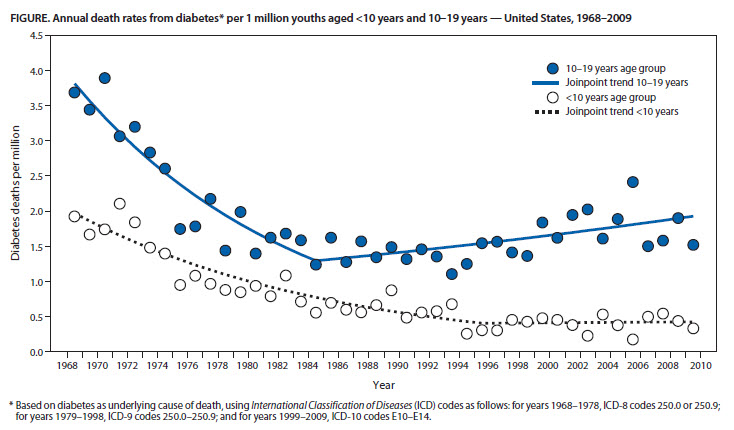Diabetes
Following are links to the large amount of data available from the CDC .
Data & Trends In particular look at the Surveillance Systems:
Read Chronic Disease Text - Chapter 10, special attention to pages 295-301. When scanning the modifiable risk factors think about areas that might be of value for translational interventions for both prevention and control. Review the section on screening and early detection and consider whether intervention for type I or type II diabetes are more likely to be affected by population interventions. At this point you may want to visit the CDC site and think about current prevention and control programs particularly those developed since the publication of this book with attention to page 313. When considering the issue of partnerships look at the American Diabetes Association web pages think about why population disparities may be present (Navigate to living with diabetes link, then click on the discrimination option), then focus on pages 316 to 319 To look at suggested areas of future research. Not only is it necessary to think about primary prevention but also about maintenance of current status, When reading articles about chronic disease look for information about integration of effort as seen in this report from the U.Missouri. Scan chapter 2 of this 2014 IOM study (review the Introductory chapter) on the current state of Obesity in the US,
Diabetes PowerPoint
Read this editorial from JAMA on the burden of diabetes
American Diabetes Association – Home Page then click on the 'diabetes basics' and 'research and practice' tabs
However for all chronic diseases we must be aware of collateral damage from treament as seen in this JAMA Editorial, I have highlighted the important points.
Diabetes mortality. How much of this change is from diabetes intervention, and how much from cardiovascular interventions.look at this 2015 NEJM editorial, Focus on the highlighted sections of this editorial rather than trying to read everything.
NEJM - 200 Years of diabetes. What are the major changes in diagnosis and treatment, including prevention over this period? Note the future challenges And then read About the challenges for population health interventions to help control diabetes. And follow with a look at Physician Competencies for Lifestyle Medicine (Review the boxed material). who else should be involved in lifestyle assessment besides physicians?
Prevention Strategies, what strategies are suggested, Are there measured outcomes (Review the 1st set of material on nutrition and obesity)? Validated baselines? JAMA 2015 Viewpoint on Prevention .look at this IOM report on a strategy to control diabetes..
Why is it so hard to get prevention strategies carried out in the doctor's office?
|Look at three recent articles, diabetes report card from the NEJM, and an Editorial from JAMA on Diabetes and Prevention, as well as another article from the NEJM on assessment of risk factors (This last article should be kept and looked at when considering each of the other chronic diseases we will deal with, as the graphics are particularly useful). As well as a BMJ artticle on behavioral change and this very recent update from the USPSTF on screening for diabetes.
Take a look this article from the February 17 New England Journal of Medicine on the value of bariatric surgery with type II diabetes and the accompanying section of the results and weight loss.


Despite major medical advances over the past three decades, a 20 year old woman with type 1 diabetes can still expect to live 13 years less than someone without the condition, a large Scottish study has concluded. For men the estimated life expectancy loss is 11 years. The prospective cohort study, published in JAMA, found that even in the absence of renal complications mortality from cardiovascular disease remained significantly more in people with type 1 diabetes than in the population without diabetes.Intensive insulin treatment is now the standard of care, and over the past 30 years significant advances have been made in insulin delivery and glucose monitoring that help in the management of type 1 diabetes. Yet for many people with type 1 diabetes glycaemic control remains suboptimal, and acute and chronic complications from diabetes persist, reducing life expectancy. Also look at this use of a mobile app to help control diabetes
What research projects currently funded by CDC are likely to have an early impact on diabetes?
Which of the current research projects on diabetes funded by the NIH appear promising to you?
One cannot think about diabetes without considering the genetics, whether type I or type II, take a look at this article which we should consider again in the section on genetics
We keep seeing publications about environmental issues affecting diseases, in this case diabetes. Do you think this makes clinical sense? Why?
Look at how death rates of youth have changed.

Lancet 2015 Theme Issue on Diabetes, look at any articles that interest you., Volume 383, Issue 9933, 7–13 June 2014, Annual issue devoted to Diabetes. Scan to find out about areas the experts believe impolrtant to forther control.
Diabetes & Genomics Sept 2015,
Research Headlines
